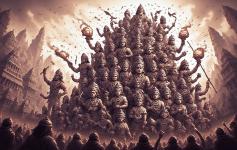Welcome to विचारमञ्जरी (Vichāramañjarī)!
Vichāramañjarī is a space for the contemplative mind. Here, we delve into the depths of thought, exploring the intricate tapestry of ideas that shape our understanding of the world.
We believe in the power of shared reflection, where curiosity and creativity intertwine to illuminate the complexities of human experience. Our blog is a platform for those seeking to engage in thoughtful discourse, to grapple with challenging questions, and to discover new perspectives on familiar themes.
We invite you to join us on this journey of intellectual exploration. Engage with our content through thoughtful comments and discussions, and contribute your own insights to the collective tapestry of knowledge.
Vichāramañjarī is a haven for those who seek to engage with the world through the lens of critical thought and profound contemplation.
Featured
The Scale Problem | Why Large Democracies Struggle with Social Revolution
Posted on 7 mins
TLDR - Summary: Large democracies face unique challenges that smaller nations avoid. India’s billion-plus population hasn’t created mathematical impossibility of consensus—it has culturally chosen to grant permanent veto power to street protests, making electoral democracy meaningless when any small group can endlessly occupy public spaces without consequence. While America demonstrates that democracies can be agile despite polarization (swinging between extremes every four years), India remains paralyzed by its need to accommodate everyone, ultimately accommodating no one.
The Kalki Paradox | Divine Intervention and the Pattern of Hindu Resistance
Posted on 9 mins
TLDR - Summary: The Jugantar revolutionary movement in early 20th-century Bengal exemplifies a recurring pattern in Hindu resistance: initial promise grounded in authentic cultural foundations, followed by secular dilution and organizational fragmentation. Founded on Sri Aurobindo’s vision of spiritual nationalism, these gymnasium-based revolutionary cells achieved tactical sophistication—publishing influential newspapers, organizing funding through ideologically-sanctioned robberies, and coordinating international conspiracies—yet ultimately dissolved into the Indian National Congress and various secular political factions.
The Indian Judiciary and Hinduism | Some notable examples of Blatant Bias
Posted on 9 mins
Read the Main Article here - A Comprehensive Indictment of the Anti-Hindu Judiciary of Modern India Judicial Views on Hinduism/Sanatana in India The Indian judiciary’s record on Hinduism and Sanatana Dharma is mixed. Supreme Court benches have often described Hinduism/Hindutva in broad, inclusive terms, but in practice some judges have made controversial remarks or rulings affecting Hindu practices. Critics point to instances of alleged bias or anti-Hindu actions. Below are key examples (with sources) of judges’ statements or rulings relating to Hinduism or religion:
The Indian Judiciary and Hinduism | A Critical Historical Analysis of Colonial Legacy and Contemporary Challenges
Posted on 12 mins
TLDR - Summary: The Systematic Judicial Assault on Sanatan Dharma: Three Centuries of Institutional Colonization This comprehensive analysis exposes the shocking truth: India’s judiciary has operated as an instrument of cultural colonization for over 250 years, systematically dismantling Hindu religious autonomy while masquerading as neutral arbiters of justice. The Colonial Foundation (1757-1947): British rulers didn’t merely govern India—they reconstructed Hindu law itself. Warren Hastings’ “codification” project and the 1864 dismissal of native religious authorities marked the beginning of epistemological warfare against dharmic jurisprudence.